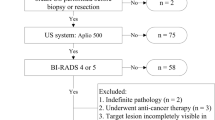Abstract
Objectives
To evaluate the relevant factors associated with malignancy in Breast Imaging Reporting and Data System (BI-RADS) 4A and to determine whether it was possible to establish a safe follow-up guideline for lower-risk 4A lesions.
Methods
In this retrospective study, patients categorized as BI-RADS 4A on ultrasound who underwent ultrasound-guided biopsy or/and surgery between June 2014 and April 2020 was analyzed. Classification-tree method and cox regression analysis were used to explore the possible correlation factors of malignancy.
Results
Among 9965 patients enrolled, 1211 (mean age, 44.3 ± 13.5 years; range, 18–91 years) patients categorized as BI-RADS 4A were eligible. The result of cox regression analysis revealed the malignant rate was only associated with patient age (hazard ratio (HR) = 1.038, p < 0.001, 95% confidence interval (CI): 1.029–1.048) and the mediolateral diameter of the lesion (HR = 1.261, p < 0.001, 95% CI: 1.159–1.372). The malignant rate for patients (≤ 36 y) with BI-RADS 4A lesions (the mediolateral diameter ≤ 0.9 cm) was 0.0% (0/72). This subgroup included fibrocystic disease and adenosis in 39 patients (54.2%), fibroadenoma in 16 (22.2%), intraductal papilloma in 8 (11.1%), inflammatory lesions in 6 (8.3%), cyst in 2 (2.8%), and hamartoma in 1 (1.4%).
Conclusions
Patient age and lesion size are associated with the rate of malignancy in BI-RADS 4A. For patients with lower-risk BI-RADS 4A lesions (≤ 2% likelihood of malignancy), short-term follow-up with ultrasound may be offered as an acceptable alternative to immediate biopsy or surgery.





Similar content being viewed by others
References
He P, Cui LG, Chen W, Yang RL (2019) Subcategorization of ultrasonographic BI-RADS category 4: assessment of diagnostic accuracy in diagnosing breast lesions and influence of clinical factors on positive predictive value. Ultrasound Med Biol 45:1253–1258
Lazarus E, Mainiero MB, Schepps B, Koelliker SL, Livingston LS (2006) BI-RADS lexicon for US and mammography: interobserver variability and positive predictive value. Radiology 239:385–391
Spak DA, Plaxco JS, Santiago L, Dryden MJ, Dogan BE (2017) BI-RADS((R)) fifth edition: a summary of changes, Diagn Interv. Imaging 98:179–190
Rao AA, Feneis J, Lalonde C, Ojeda-Fournier H (2016) A pictorial review of changes in the BI-RADS fifth edition. Radiographics 36:623–639
Stavros AT, Freitas AG, deMello GGN, Barke L, McDonald D, Kaske T, Wolverton D, Honick A, Stanzani D, Padovan AH, Moura APC, de Campos MCV (2017) Ultrasound positive predictive values by BI-RADS categories 3–5 for solid masses: an independent reader study. Eur Radiol 27:4307–4315
Hu Y, Yang Y, Gu R, Jin L, Shen S, Liu F, Wang H, Mei J, Jiang X, Liu Q, Su F (2018) Does patient age affect the PPV3 of ACR BI-RADS ultrasound categories 4 and 5 in the diagnostic setting? Eur Radiol 28:2492–2498
Chaiwerawattana A, Thanasitthichai S, Boonlikit S, Apiwanich C, Worawattanakul S, Intakawin A, Rakiad S, Thongkham K (2012) Clinical outcome of breast cancer BI-RADS 4 lesions during 2003–2008 in the national cancer institute Thailand. Asian Pac J Cancer Prev 13:4063–4066
Fu CY, Hsu HH, Yu JC, Hsu GC, Hsu KF, Chan DC, Ku CH, Lu TC, Chu CH (2011) Influence of age on PPV of sonographic BI-RADS categories 3, 4, and 5. Ultraschall Med 32(Suppl 1):S8-13
Zou X, Wang J, Lan X, Lin Q, Han F, Liu L, Li A (2016) Assessment of diagnostic accuracy and efficiency of categories 4 and 5 of the second edition of the BI-RADS ultrasound lexicon in diagnosing breast lesions. Ultrasound Med Biol 42:2065–2071
Flowers CI, O’Donoghue C, Moore D, Goss A, Kim D, Kim JH, Elias SG, Fridland J, Esserman LJ (2013) Reducing false-positive biopsies: a pilot study to reduce benign biopsy rates for BI-RADS 4A/B assessments through testing risk stratification and new thresholds for intervention. Breast Cancer Res Treat 139:769–777
Yoon JH, Kim MJ, Moon HJ, Kwak JY, Kim EK (2011) Subcategorization of ultrasonographic BI-RADS category 4: positive predictive value and clinical factors affecting it. Ultrasound Med Biol 37:693–699
Spinelli Varella MA, Teixeira da Cruz J, Rauber A, Varella IS, Fleck JF, Moreira LF (2018) Role of BI-RADS ultrasound subcategories 4A to 4C in predicting breast cancer. Clin Breast Cancer 18:e507–e511
Liu G, Zhang MK, He Y, Liu Y, Li XR, Wang ZL (2019) BI-RADS 4 breast lesions: could multi-mode ultrasound be helpful for their diagnosis? Gland Surg 8:258–270
Stavros AT (2003) Breast ultrasound. Lippincott Williams & Wilkins, Philadelphia
Fan L, Strasser-Weippl K, Li JJ, St Louis J, Finkelstein DM, Yu KD, Chen WQ, Shao ZM, Goss PE (2014) Breast cancer in China. Lancet Oncol 15:e279-289
Funding
This research did not receive any specific grant from funding agencies in the public, commercial, or not-for-profit sectors.
Author information
Authors and Affiliations
Corresponding author
Ethics declarations
Conflict of interest
The authors declare that they have no conflict of interest.
Informed consent
This retrospective study was approved by our institutional review board and the requirement to obtain informed consent was waived.
Additional information
Publisher's Note
Springer Nature remains neutral with regard to jurisdictional claims in published maps and institutional affiliations.
Rights and permissions
Springer Nature or its licensor (e.g. a society or other partner) holds exclusive rights to this article under a publishing agreement with the author(s) or other rightsholder(s); author self-archiving of the accepted manuscript version of this article is solely governed by the terms of such publishing agreement and applicable law.
About this article
Cite this article
He, P., Chen, W., Cui, LG. et al. Can Short-term Follow-up with Ultrasound be Offered as an Acceptable Alternative to Immediate Biopsy or Surgery for Patients with First Ultrasound Diagnosis of BI-RADS 4A Lesions?. World J Surg 47, 2161–2168 (2023). https://doi.org/10.1007/s00268-023-07037-x
Accepted:
Published:
Issue Date:
DOI: https://doi.org/10.1007/s00268-023-07037-x




